Jeep
![]()
This article or subsequent section is not sufficiently supported by evidence (e.g., anecdotal evidence). Information without sufficient evidence may be removed in the near future. Please help Wikipedia by researching the information and adding good supporting evidence.
![]()
This article is about the car brand Jeep of Fiat Chrysler Automobiles N.V. Other meanings are listed under Jeep (disambiguation).
Jeep is a US automobile brand that was part of the Fiat Chrysler Automobiles group until 2020. Its direct parent company was Chrysler Group LLC. After the merger of PSA and FCA, Jeep is one of the brands in the newly formed Stellantis Group.
Only off-road vehicles are produced. Over the course of time, the name Jeep - similar to Tesa and Tempo - has developed into a generic name in Europe (with the difference, however, that the term Jeep was not established as a trademark, but had already been used for the US military off-road vehicle Willys MB). For this reason, other off-road vehicles are sometimes colloquially referred to as "Jeep" in Europe, while the term SUV (sport utility vehicle) has become established in the USA.
History
Word origin
The origin of the word Jeep is not clear. The most popular theory is the derivation from the abbreviation GP for General Purpose. However, Lee Ermey recently refuted this theory in his documentary series. The vehicle was developed for special purposes and therefore never called General Purpose. Instead, the derivation is possible from a factory code used by Ford, which is also GP (G for government-use, and P as a designation for 80 inch wheelbase). Dissenting from this, many, including Lee Ermey, theorize that the name derives from the character Eugene the Jeep from the comic strip Popeye. This dog-like mythical creature preferred to feed on orchids and was able to walk through walls and ceilings, climb trees as well as fly - so it was able to appear anywhere it wanted. In addition, it repeatedly helped the protagonist Popeye out of awkward situations. It is assumed that the soldiers were so enthusiastic about the capabilities of the new vehicle that they named it "Jeep" in reference to this comic character.
In the probability ranking of all these derivations of Jeep, Eugene the Jeep has the first place. Because in the tender of 27 June 1940 of the US Department of Defense for the construction of the military vehicle, there was never any mention of a General Purpose Vehicle (GP), but always only of a "1/4 ton 4×4". The only manufacturer that nevertheless used the abbreviation GP for its product was Ford (but not for general purpose).
The name Jeep was first made public by the chief test driver of Willys-Overland, Irving Red Hausmann, in February 1941, when he presented "his" Jeep to the press. The story goes that he drove the Jeep up the Capitol steps in Washington during the press presentation - accompanied by Washington Daily News journalist Katherine Hillyer. Back at the bottom of the stairs, one of the audience members asked what kind of car it was. Hausmann: "It's a Jeep." Hillyer adopted that name for her article - and with that, the name Jeep was established for all time, and was even accepted by the military as an official designation. The article with the photo of the Willys MB complete with Jeep in the caption appeared in the Washington Daily News on February 20, 1941.
The jeeps of the US Army
As early as 1938, the American Bantam company presented its BRC (Bantam Reconnaissance Car) to the US Army. While the Army was enthusiastic about the capabilities of this light reconnaissance vehicle, it could not afford such a project at the time. However, with the onset of World War II and reports of the German Army's high mobility, there was a need for the Army to take action. So, on 27 June 1940, a tender was launched with the brief to design a 4×4 off-road vehicle at ¼ ton payload. Although this RFP was issued to some 135 firms, interest among the American automotive industry was vanishingly small. It was simply not profitable for the manufacturers of agricultural vehicles and trucks at the time to meet the tight deadlines (design plans and first prototypes within 49 days and 70 finished test cars after another 26 days) and the requirement for such a light vehicle, since they normally produced large, heavy work machines. However, Bantam (which was formed from the US offshoot of a British small car manufacturer) had enough experience with small, light vehicles - not least through the aforementioned BRC. As Bantam was in a big crisis and had to take every possibility to save the company from going out of business, they did not hesitate and did everything to meet the requirements of the Army, which again was convinced of the qualities of the Bantam. Willys-Overland, which was facing similar financial problems as Bantam, also participated in the tender, but unlike Bantam, they were unable to complete their prototype in time.
However, since the need for the new vehicle was very acute and the small Bantam company with its single plant was too uncertain to be the sole supplier, the Department of Defense also convinced the Ford Motor Company to enter the project. Although Ford was initially reluctant, the MoD eventually succeeded in convincing the company (albeit only after deciding to order 1500 vehicles from each bidder). The three companies now involved now had a target of producing 1500 vehicles each that matched the performance of the Bantam. To make this possible, Ford and Willys-Overland were given access to the BRC's designs, despite protests from Bantam. This also meant that there was little difference between the three vehicles, both visually and technically.
After extensive testing, the Army decided on the "Willys MA" from Willys-Overland. The decisive factor here was the powerful "Go-Devil" engine, which, at 60 hp, had about 25 % more power than the engine of the BRC-40. Willys reworked the MA again in the style of the Ford GP and from then on produced the legendary "Willys MB" - by the end of the war just over 360,000 units had been completed. Ford in turn took over the design of the Willys MB (military model, variant B) and produced the GPW (governmental, P for the 80 inch wheelbase and W for Willys, because Ford took over the design for mass production) - at Ford about 270,000 Jeeps rolled off the production line until the end of the war.
After the end of the Second World War, Ford ceased Jeep production. Willys-Overland, on the other hand, developed the MB's successor, the M38, a few years later. This evolved from the civilian CJ-3A and was delivered to the US Army with a reinforced frame, 24 V electrical system and some other military improvements with about 60,000 vehicles produced (1950-1952). The last Jeep for the US Army was the M38A1 (1951-1971). This too achieved a high profile, eventually being used until the 1970s (and therefore also in the Vietnam War) until it was finally replaced by the M151 MUTT.
The current descendant of the legendary Jeeps is now the HMMWV from AM General. Similar to the Jeep, a civilian version of this vehicle (usually called Humvee by soldiers) was also produced, from which a car brand developed: the Hummer. And analogous to the Jeep, the Hummer brand was also sold to General Motors in the meantime, but the company discontinued the brand in March 2010.
The jeep becomes civilian
Already during the Second World War, Willys-Overland planned to market the Jeep for civilian use. On July 17, 1945, the time had come: The first CJ-2A rolled off the assembly line (Civilian Jeep). Since this one didn't have to meet the military weight requirements, it could even be equipped with an improved drivetrain and an improved version of the Go-Devil engine. Soon, other Willys vehicles were sold under the Jeep brand. The CJ series continued until 1987, through the changing owners of the Jeep brand and also through some new model lines (some of which were again influenced by military developments). The last model in the CJ line was the CJ-7 (and the longer CJ-8) which was replaced by the Jeep Wrangler (YJ) developed by AMC.
In 1950, Willys-Overland was finally awarded the sole trademark rights for "Jeep" in court after Bantam filed a lawsuit claiming that they had already used the name "Jeep" before Willys-Overland. Since then, the brand changed hands several more times. In 1953, Willys was purchased by Kaiser-Frazer, and in 1963 the company was renamed Kaiser-Jeep. American Motors Corporation bought out the company in 1970. In 1987, AMC was again bought out by Chrysler Corporation and became the "Jeep-Eagle Division". When Chrysler and Daimler-Benz merged in 1998, the unprofitable Eagle brand was dropped. Since then, Jeep was part of DaimlerChrysler AG, with the sale of Chrysler to Cerberus in 2007, the Jeep brand remained with Chrysler Group LLC.
The Jeep brand today
The Jeep brand is now a division of the Chrysler corporation, which holds the marketing rights to the word "Jeep" and the distinctive O|O grille design with seven rounded long cutouts. The first Willys MB had a different design (several flat struts of strip steel strung together), however Willys-Overland soon adopted the Ford GPW's nine-spoke grille as it weighed less than Willys' classic "slat grille".
However, Chrysler (after losing a lawsuit, then DaimlerChrysler) had to allow an exception for this design: General Motors was allowed to use a similar design for its Hummer brand, because the Jeep brand was owned by AMC at the time of the development of the HMMWV (the military model of the Hummer). AM General (a subsidiary of AMC at the time) was developing the "Humvee" in the early 1980s and was therefore allowed to use the (at the time) corporate-owned Jeep design. When AM General sold the trademark rights for Hummer to General Motors, GM also took over the right to use said grille for this brand. Since 2010, however, the Hummer brand is no longer produced.
Furthermore, Jeeps are now built in Beijing by Beijing Jeep Corporation, Ltd (a joint venture between Beijing Automobile Industry Corporation, DaimlerChrysler and DaimlerChrysler China Invest Corporation, established on 15 January 1984), in India by Mahindra & Mahindra Limited and in Graz by Magna Steyr.
Radiator grille and logo
Old military Jeeps had or have 9 vertical slots in the grille pressed from sheet metal. Modern SUVs have only 7 slots. The current (2018) Jeep brand logo shows stylized 7 slots between 2 high-mounted headlights. °|||||||°
.jpg)
The Jeep Grand Cherokee built from 2014 to 2017 in the "Summit" trim level, with the second facelifted model to follow starting in model year 2018.
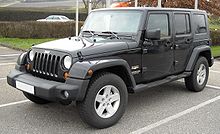
Wrangler Unlimited
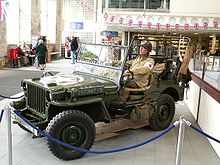
Willys MB in a British museum
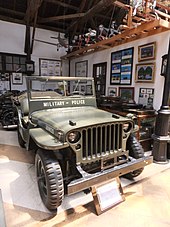
Ford GPW

Jeep Willys MB Year of construction 1945
Models
Timeline
| Timeline of civilian Jeep models from 1945 to today | ||||||||||||
| Parent company | Willys-Overland Motors | Kaiser Motors | American Motors Corporation | Chrysler Corporation | DaimlerChrysler AG | Chrysler LLC Stellantis | ||||||
| Manufacturer | Willys Motor Company | Kaiser Jeep Corporation | Jeep Corporation | Jeep Eagle Division | Jeep Division | |||||||
| Type | 1940s | 1950s | 1960s | 1970s | 1980s | 1990s | 2000s | 2010s 2020s | ||||
| 5 | 6 | 7 | 8 | 9 | 0 | 1 | 2 | 3 | 4 | 5 | 6 | 7 | 8 | 9 | 0 | 1 | 2 | 3 | 4 | 5 | 6 | 7 | 8 | 9 | 0 | 1 | 2 | 3 | 4 | 5 | 6 | 7 | 8 | 9 | 0 | 1 | 2 | 3 | 4 | 5 | 6 | 7 | 8 | 9 | 0 | 1 | 2 | 3 | 4 | 5 | 6 | 7 | 8 | 9 | 0 | 1 | 2 | 3 | 4 | 5 | 67 8 9 0 1 2 3 4 5 6 7 8 9 0 1 | |
| SUV | CJ-2A | CJ-3A | CJ-3B | CJ-7 | Wrangler (YJ) | Wrangler (TJ) | Wrangler (JK) Wrangler (JL) | |||||||||||||||||||||||||||||||||||||||||||||||||||||||
| CJ-5 | ||||||||||||||||||||||||||||||||||||||||||||||||||||||||||||||
| CJ-6 | ||||||||||||||||||||||||||||||||||||||||||||||||||||||||||||||
| SUV | Renegade | |||||||||||||||||||||||||||||||||||||||||||||||||||||||||||||
| Compass (MK) Compass (MP) | ||||||||||||||||||||||||||||||||||||||||||||||||||||||||||||||
| Patriot (MK) | ||||||||||||||||||||||||||||||||||||||||||||||||||||||||||||||
| Jeepster (VJ) | Jeepster Commando (C-101) | Commando (C-104) | Cherokee (XJ) | Cherokee/ Liberty (KJ) | Cherokee/ Liberty (KK) Cherokee | |||||||||||||||||||||||||||||||||||||||||||||||||||||||||
| Station Wagon | Wagoneer / Cherokee (SJ) | Grand Wagoneer (SJ) | Grand Cherokee (ZJ) | Grand Cherokee (WJ) | Grand Cherokee (WK) | Grand Cherokee (WK2) | ||||||||||||||||||||||||||||||||||||||||||||||||||||||||
| Commander (XK) Grand Commander | ||||||||||||||||||||||||||||||||||||||||||||||||||||||||||||||
| (Grand) Wagoneer (WS) | ||||||||||||||||||||||||||||||||||||||||||||||||||||||||||||||
| Pick-up | Truck | CJ-8/CJ-10 | Comanche (MJ) | |||||||||||||||||||||||||||||||||||||||||||||||||||||||||||
| Gladiator (SJ) | Pickup (J-Series)/Honcho | |||||||||||||||||||||||||||||||||||||||||||||||||||||||||||||
| Delivery van | DJ-3A | DJ-5/6 | Gladiator (JT) | |||||||||||||||||||||||||||||||||||||||||||||||||||||||||||
| FJ-3/3A | ||||||||||||||||||||||||||||||||||||||||||||||||||||||||||||||
| FC-150/FC-170 | ||||||||||||||||||||||||||||||||||||||||||||||||||||||||||||||
Classic models of the Jeep brand
1940-1953: Jeep by Willys
- 1940-1945 (Willys MB)
- 1945-1949 CJ-2A
- 1946-1965 Station Wagon
- 1948-1950 Jeepster VJ
- 1949-1953 CJ-3A
- 1949-1963 Pick-Up
- 1950/51 M38
- 1951-1971 M38A1
1953-1970: Jeep by Kaiser-Frazer (1963-1970: Kaiser-Jeep)
- 1953-1964 CJ-3B
- 1955-1968 CJ-5
- 1955-1981 CJ-6
- 1957-1965 FC-150 & FC-170 (Pick-Up & Trucks)
- 1962-1983 Wagoneer (SJ; predecessor of the 84 Cherokees)
- 1963-1970 Gladiator (SJ)
- 1966 Super Wagoneer (special model)
- 1967-1973 Jeepster Commando
1970-1986: Jeep by AMC (1982-1986: AMC-Renault)
- 1971-1986 Honcho (Pick-Up & Trucks)
- 1974-1983 Cherokee Chief (two-door model of the Wagoneer)
- 1976-1986 Jeep CJ-7
- 1984-1996 Cherokee (XJ)
- 1984-1987 CJ-8
- 1985-1992 Comanche (pick-up version of the Cherokee XJ, last pick-up from Jeep)
Since 1986: Jeep by Chrysler (1998 to 2007 DaimlerChrysler)
- 1993-1998 Grand Cherokee ZJ = USA/ZG = EU
- 1987-1995 Wrangler YJ (square headlights, developed by AMC)
- 1997-2001 Cherokee (XJ, revised version)
- 1997-2006 Wrangler TJ
- 2006-2010 Jeep Commander XH
- 2001-2008 Cherokee KJ (in North America Jeep Liberty)
- 2007-2017 Jeep Patriot
- 2007-2018 Wrangler JK
Current Jeep models
- since 2013 Jeep Cherokee KL
- since 2016 Jeep Compass
- since 2019 Jeep Gladiator JT
- since 2010 Jeep Grand Cherokee WK2
- since 2018 Jeep Grand Commander
- since 2021 Jeep Grand Wagoneer WS
- since 2014 Jeep Renegade
- since 2021 Jeep Wagoneer WS
- since 2018 Jeep Wrangler JL
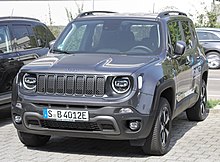
Jeep Renegade PHEV
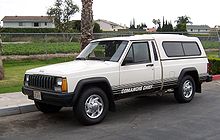
Comanche Chief

Jeep Gladiator with camping body

1948 Willys Jeepster (VJ)
Search within the encyclopedia